ECON6000 Economic Principles: Analyzing Trade, Tariffs & Demand
VerifiedAdded on 2023/06/09
|7
|860
|303
Homework Assignment
AI Summary
This economics assignment explores the impact of tariffs and trade agreements on the demand for energy bars. It includes a regression analysis demonstrating the relationship between average income, tariff rates, the number of stores, and energy bar demand. The assignment highlights the negative impact of tariffs on the demand for imported energy bars, showing how increased prices due to tariffs lead to decreased demand. It also discusses the potential benefits of a free trade agreement, arguing that removing tariffs would maintain stable prices and uninterrupted supply. The analysis uses supply and demand diagrams to illustrate the effects of tariffs on the quantity demanded of imported energy bars. This document is available on Desklib, a platform offering a wide range of study tools and solved assignments for students.
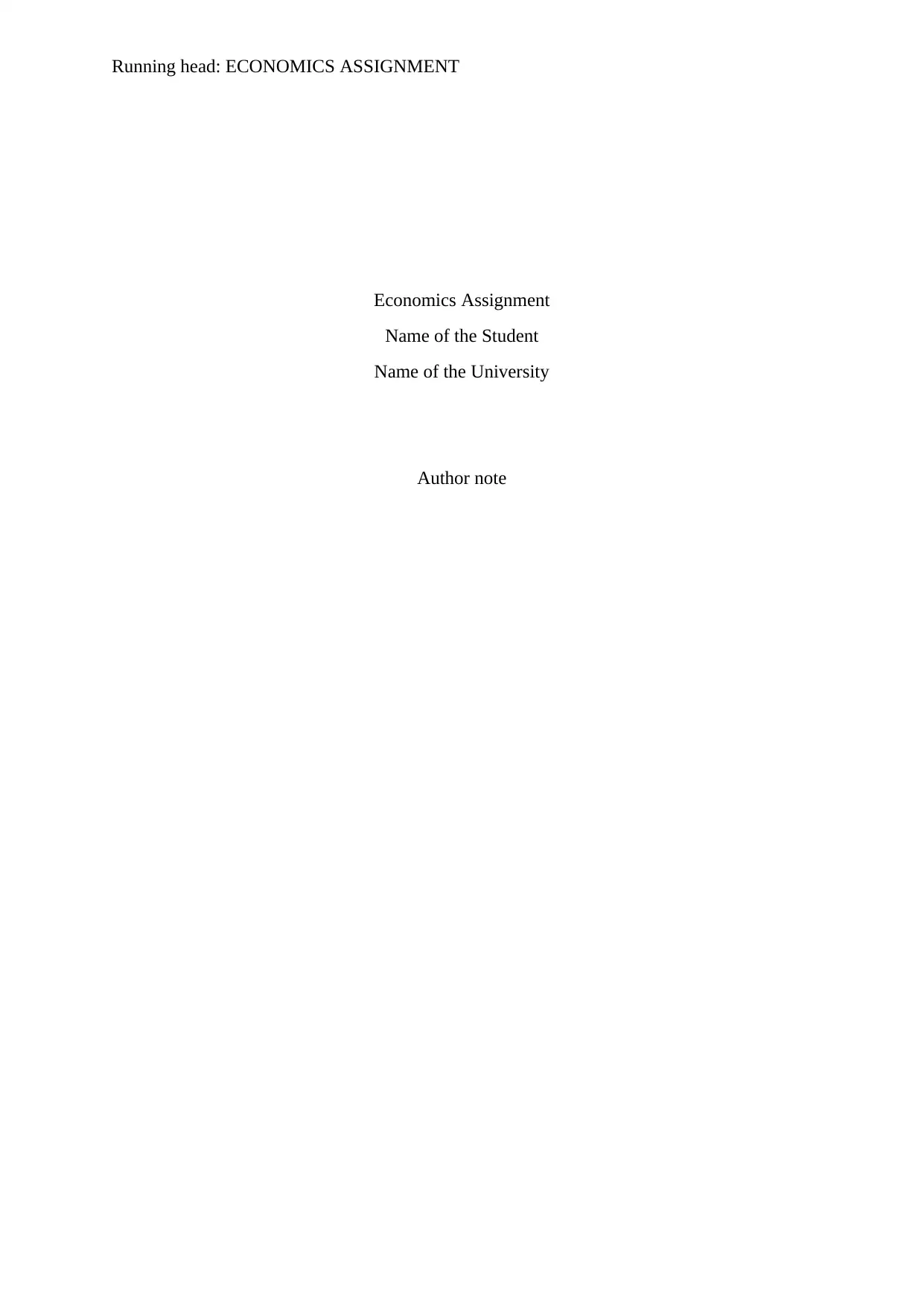
Running head: ECONOMICS ASSIGNMENT
Economics Assignment
Name of the Student
Name of the University
Author note
Economics Assignment
Name of the Student
Name of the University
Author note
Paraphrase This Document
Need a fresh take? Get an instant paraphrase of this document with our AI Paraphraser
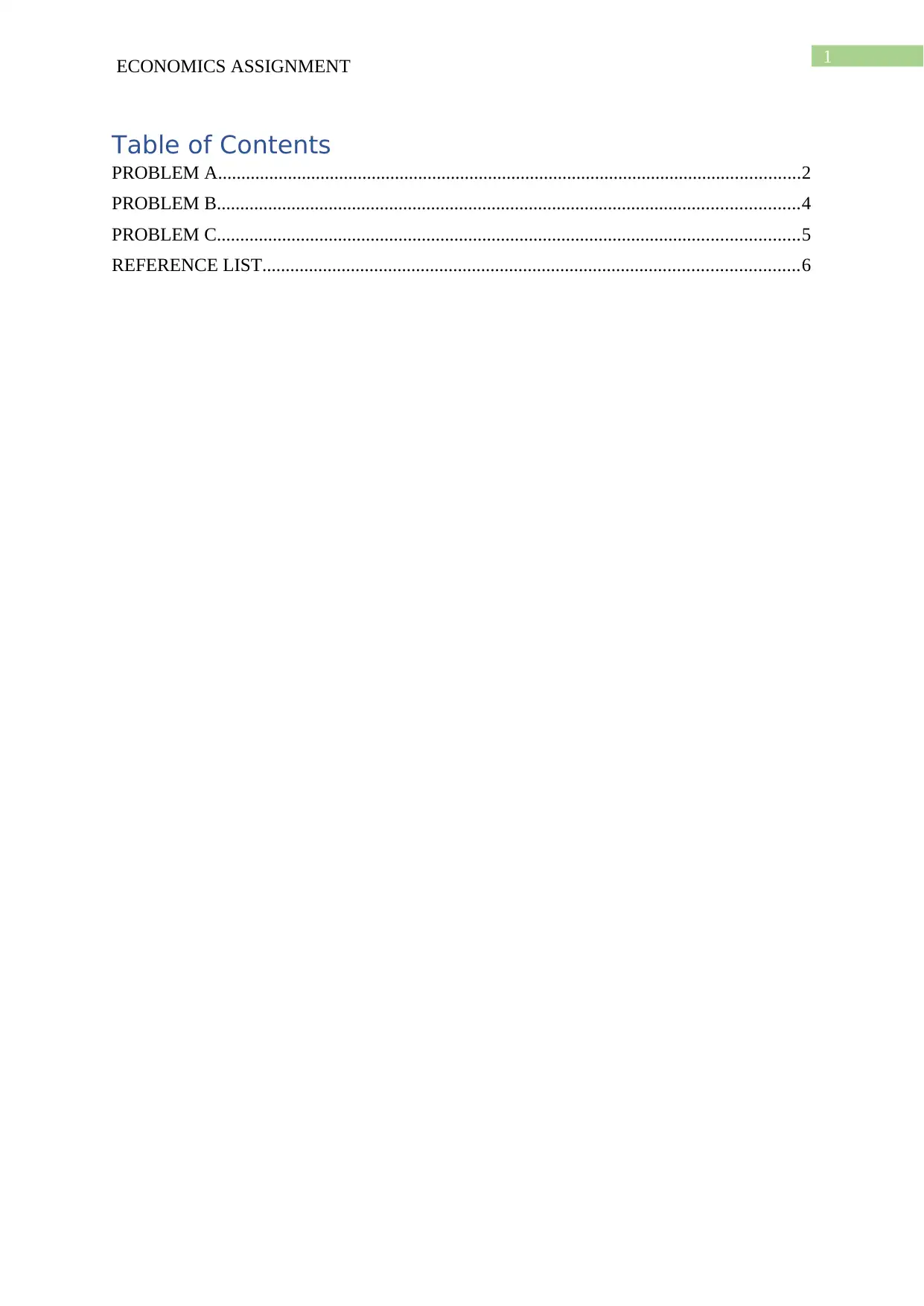
1
ECONOMICS ASSIGNMENT
Table of Contents
PROBLEM A.............................................................................................................................2
PROBLEM B.............................................................................................................................4
PROBLEM C.............................................................................................................................5
REFERENCE LIST...................................................................................................................6
ECONOMICS ASSIGNMENT
Table of Contents
PROBLEM A.............................................................................................................................2
PROBLEM B.............................................................................................................................4
PROBLEM C.............................................................................................................................5
REFERENCE LIST...................................................................................................................6
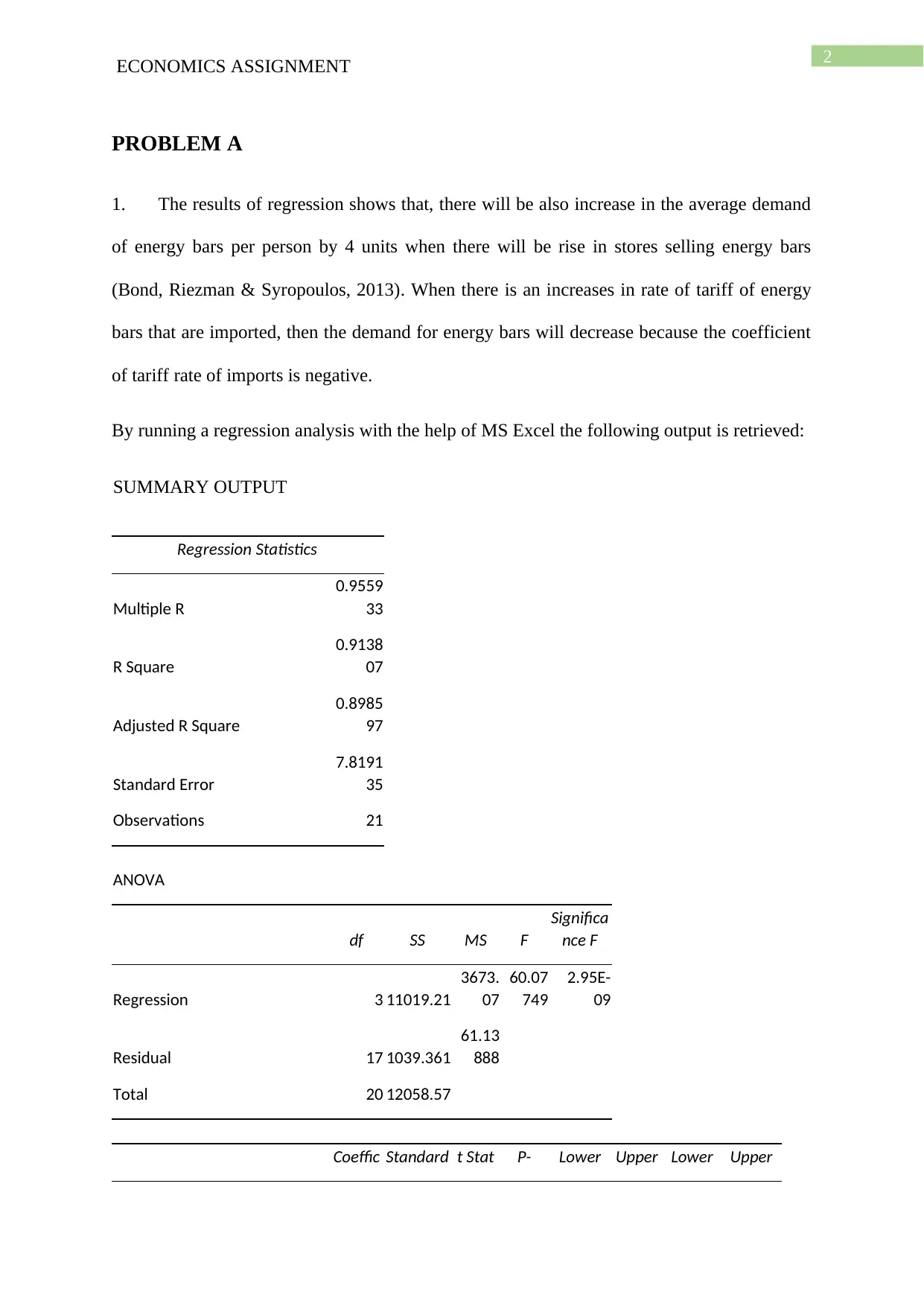
2
ECONOMICS ASSIGNMENT
PROBLEM A
1. The results of regression shows that, there will be also increase in the average demand
of energy bars per person by 4 units when there will be rise in stores selling energy bars
(Bond, Riezman & Syropoulos, 2013). When there is an increases in rate of tariff of energy
bars that are imported, then the demand for energy bars will decrease because the coefficient
of tariff rate of imports is negative.
By running a regression analysis with the help of MS Excel the following output is retrieved:
SUMMARY OUTPUT
Regression Statistics
Multiple R
0.9559
33
R Square
0.9138
07
Adjusted R Square
0.8985
97
Standard Error
7.8191
35
Observations 21
ANOVA
df SS MS F
Significa
nce F
Regression 3 11019.21
3673.
07
60.07
749
2.95E-
09
Residual 17 1039.361
61.13
888
Total 20 12058.57
Coeffic Standard t Stat P- Lower Upper Lower Upper
ECONOMICS ASSIGNMENT
PROBLEM A
1. The results of regression shows that, there will be also increase in the average demand
of energy bars per person by 4 units when there will be rise in stores selling energy bars
(Bond, Riezman & Syropoulos, 2013). When there is an increases in rate of tariff of energy
bars that are imported, then the demand for energy bars will decrease because the coefficient
of tariff rate of imports is negative.
By running a regression analysis with the help of MS Excel the following output is retrieved:
SUMMARY OUTPUT
Regression Statistics
Multiple R
0.9559
33
R Square
0.9138
07
Adjusted R Square
0.8985
97
Standard Error
7.8191
35
Observations 21
ANOVA
df SS MS F
Significa
nce F
Regression 3 11019.21
3673.
07
60.07
749
2.95E-
09
Residual 17 1039.361
61.13
888
Total 20 12058.57
Coeffic Standard t Stat P- Lower Upper Lower Upper
⊘ This is a preview!⊘
Do you want full access?
Subscribe today to unlock all pages.

Trusted by 1+ million students worldwide
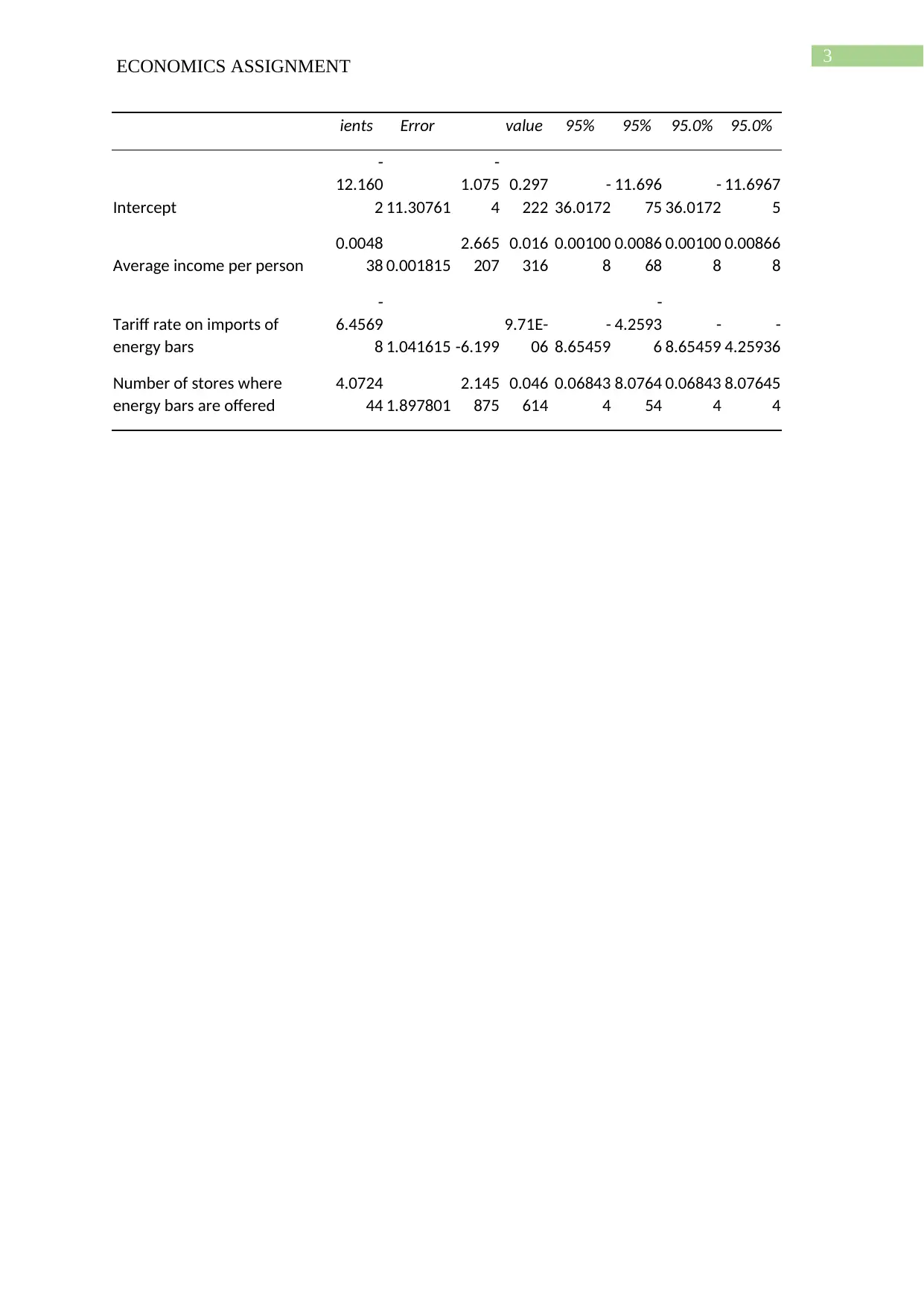
3
ECONOMICS ASSIGNMENT
ients Error value 95% 95% 95.0% 95.0%
Intercept
-
12.160
2 11.30761
-
1.075
4
0.297
222
-
36.0172
11.696
75
-
36.0172
11.6967
5
Average income per person
0.0048
38 0.001815
2.665
207
0.016
316
0.00100
8
0.0086
68
0.00100
8
0.00866
8
Tariff rate on imports of
energy bars
-
6.4569
8 1.041615 -6.199
9.71E-
06
-
8.65459
-
4.2593
6
-
8.65459
-
4.25936
Number of stores where
energy bars are offered
4.0724
44 1.897801
2.145
875
0.046
614
0.06843
4
8.0764
54
0.06843
4
8.07645
4
ECONOMICS ASSIGNMENT
ients Error value 95% 95% 95.0% 95.0%
Intercept
-
12.160
2 11.30761
-
1.075
4
0.297
222
-
36.0172
11.696
75
-
36.0172
11.6967
5
Average income per person
0.0048
38 0.001815
2.665
207
0.016
316
0.00100
8
0.0086
68
0.00100
8
0.00866
8
Tariff rate on imports of
energy bars
-
6.4569
8 1.041615 -6.199
9.71E-
06
-
8.65459
-
4.2593
6
-
8.65459
-
4.25936
Number of stores where
energy bars are offered
4.0724
44 1.897801
2.145
875
0.046
614
0.06843
4
8.0764
54
0.06843
4
8.07645
4
Paraphrase This Document
Need a fresh take? Get an instant paraphrase of this document with our AI Paraphraser
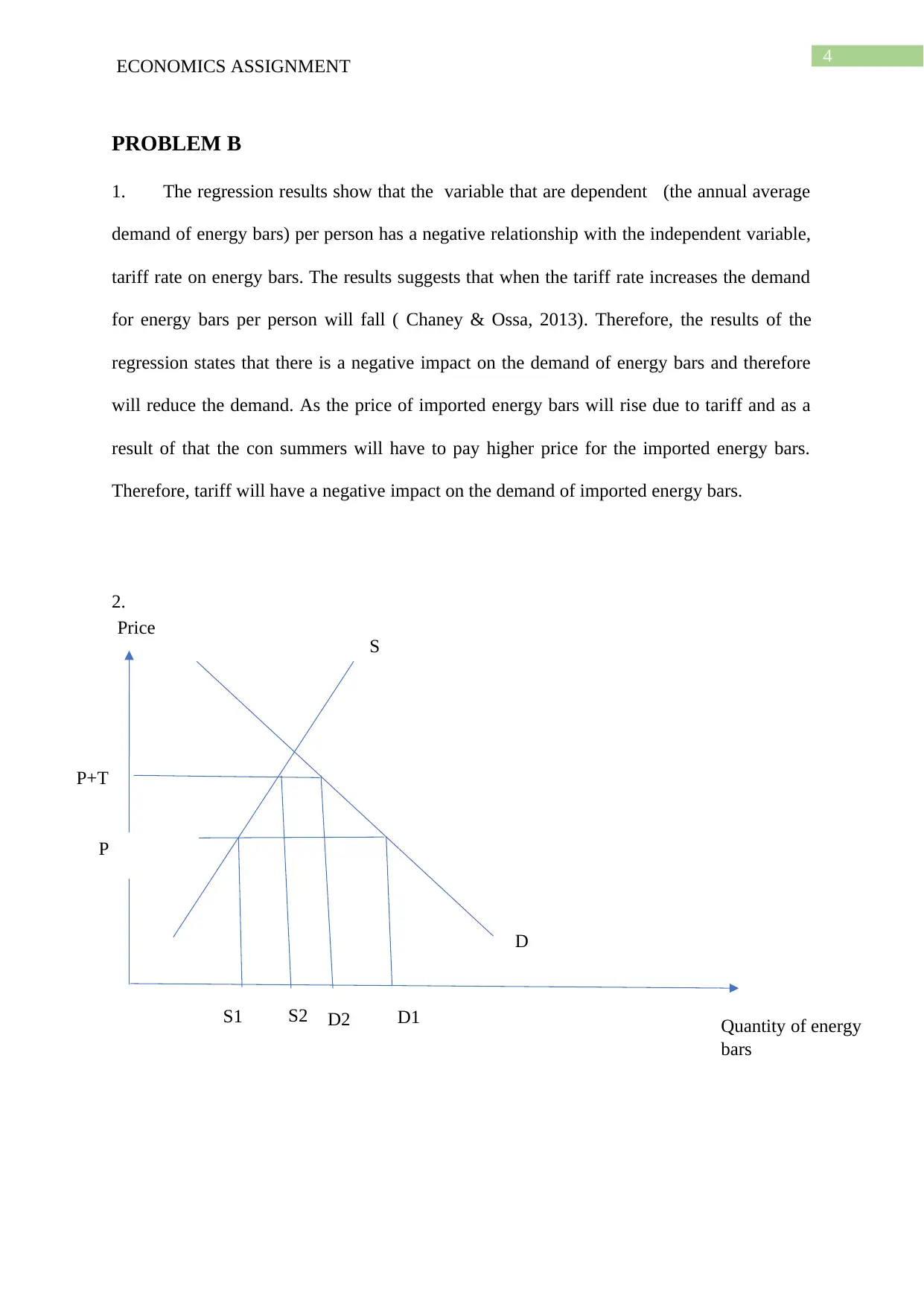
4
ECONOMICS ASSIGNMENT
PROBLEM B
1. The regression results show that the variable that are dependent (the annual average
demand of energy bars) per person has a negative relationship with the independent variable,
tariff rate on energy bars. The results suggests that when the tariff rate increases the demand
for energy bars per person will fall ( Chaney & Ossa, 2013). Therefore, the results of the
regression states that there is a negative impact on the demand of energy bars and therefore
will reduce the demand. As the price of imported energy bars will rise due to tariff and as a
result of that the con summers will have to pay higher price for the imported energy bars.
Therefore, tariff will have a negative impact on the demand of imported energy bars.
2.
S
D
P
P+T
S1 S2 D2 D1 Quantity of energy
bars
Price
ECONOMICS ASSIGNMENT
PROBLEM B
1. The regression results show that the variable that are dependent (the annual average
demand of energy bars) per person has a negative relationship with the independent variable,
tariff rate on energy bars. The results suggests that when the tariff rate increases the demand
for energy bars per person will fall ( Chaney & Ossa, 2013). Therefore, the results of the
regression states that there is a negative impact on the demand of energy bars and therefore
will reduce the demand. As the price of imported energy bars will rise due to tariff and as a
result of that the con summers will have to pay higher price for the imported energy bars.
Therefore, tariff will have a negative impact on the demand of imported energy bars.
2.
S
D
P
P+T
S1 S2 D2 D1 Quantity of energy
bars
Price
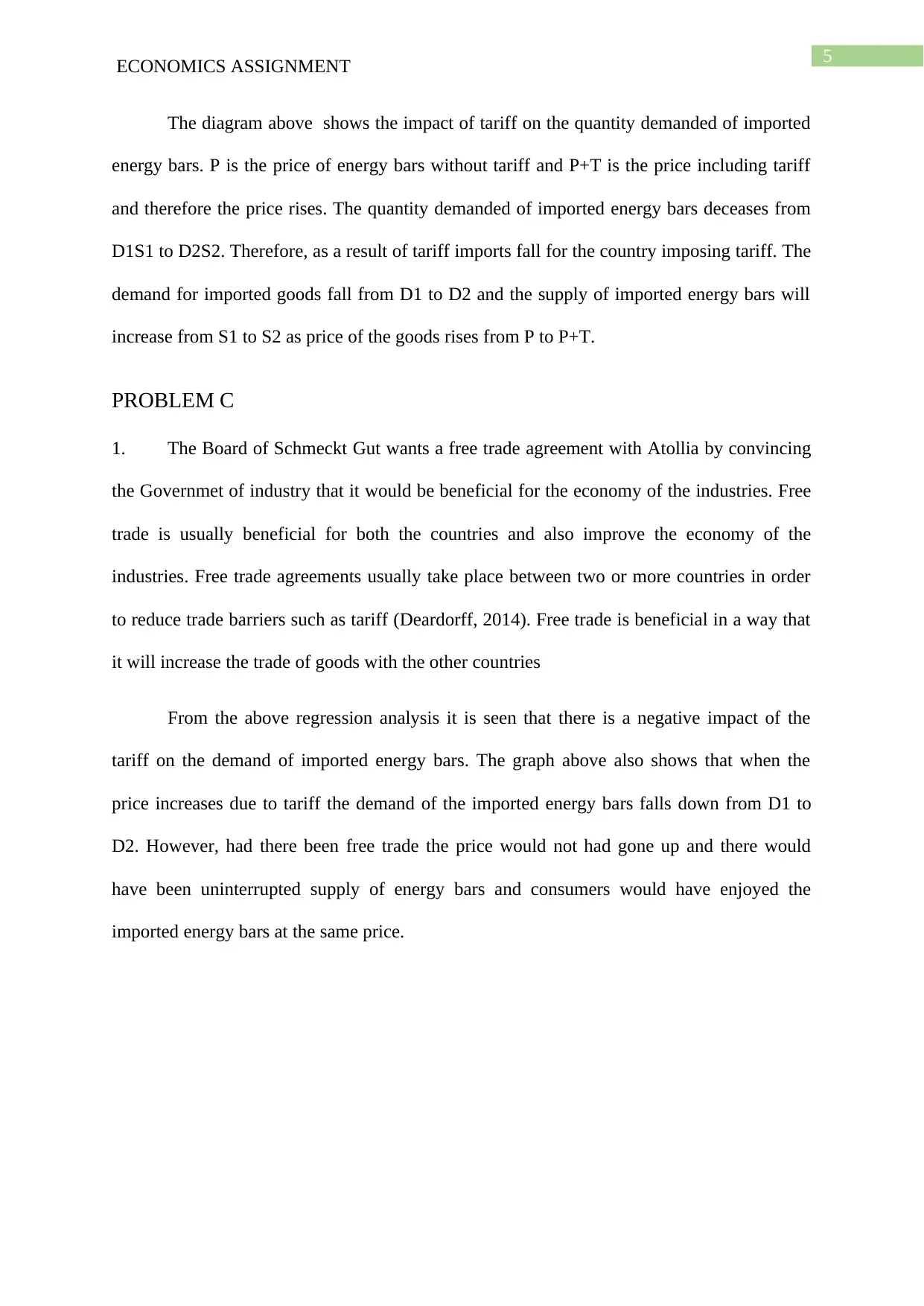
5
ECONOMICS ASSIGNMENT
The diagram above shows the impact of tariff on the quantity demanded of imported
energy bars. P is the price of energy bars without tariff and P+T is the price including tariff
and therefore the price rises. The quantity demanded of imported energy bars deceases from
D1S1 to D2S2. Therefore, as a result of tariff imports fall for the country imposing tariff. The
demand for imported goods fall from D1 to D2 and the supply of imported energy bars will
increase from S1 to S2 as price of the goods rises from P to P+T.
PROBLEM C
1. The Board of Schmeckt Gut wants a free trade agreement with Atollia by convincing
the Governmet of industry that it would be beneficial for the economy of the industries. Free
trade is usually beneficial for both the countries and also improve the economy of the
industries. Free trade agreements usually take place between two or more countries in order
to reduce trade barriers such as tariff (Deardorff, 2014). Free trade is beneficial in a way that
it will increase the trade of goods with the other countries
From the above regression analysis it is seen that there is a negative impact of the
tariff on the demand of imported energy bars. The graph above also shows that when the
price increases due to tariff the demand of the imported energy bars falls down from D1 to
D2. However, had there been free trade the price would not had gone up and there would
have been uninterrupted supply of energy bars and consumers would have enjoyed the
imported energy bars at the same price.
ECONOMICS ASSIGNMENT
The diagram above shows the impact of tariff on the quantity demanded of imported
energy bars. P is the price of energy bars without tariff and P+T is the price including tariff
and therefore the price rises. The quantity demanded of imported energy bars deceases from
D1S1 to D2S2. Therefore, as a result of tariff imports fall for the country imposing tariff. The
demand for imported goods fall from D1 to D2 and the supply of imported energy bars will
increase from S1 to S2 as price of the goods rises from P to P+T.
PROBLEM C
1. The Board of Schmeckt Gut wants a free trade agreement with Atollia by convincing
the Governmet of industry that it would be beneficial for the economy of the industries. Free
trade is usually beneficial for both the countries and also improve the economy of the
industries. Free trade agreements usually take place between two or more countries in order
to reduce trade barriers such as tariff (Deardorff, 2014). Free trade is beneficial in a way that
it will increase the trade of goods with the other countries
From the above regression analysis it is seen that there is a negative impact of the
tariff on the demand of imported energy bars. The graph above also shows that when the
price increases due to tariff the demand of the imported energy bars falls down from D1 to
D2. However, had there been free trade the price would not had gone up and there would
have been uninterrupted supply of energy bars and consumers would have enjoyed the
imported energy bars at the same price.
⊘ This is a preview!⊘
Do you want full access?
Subscribe today to unlock all pages.

Trusted by 1+ million students worldwide
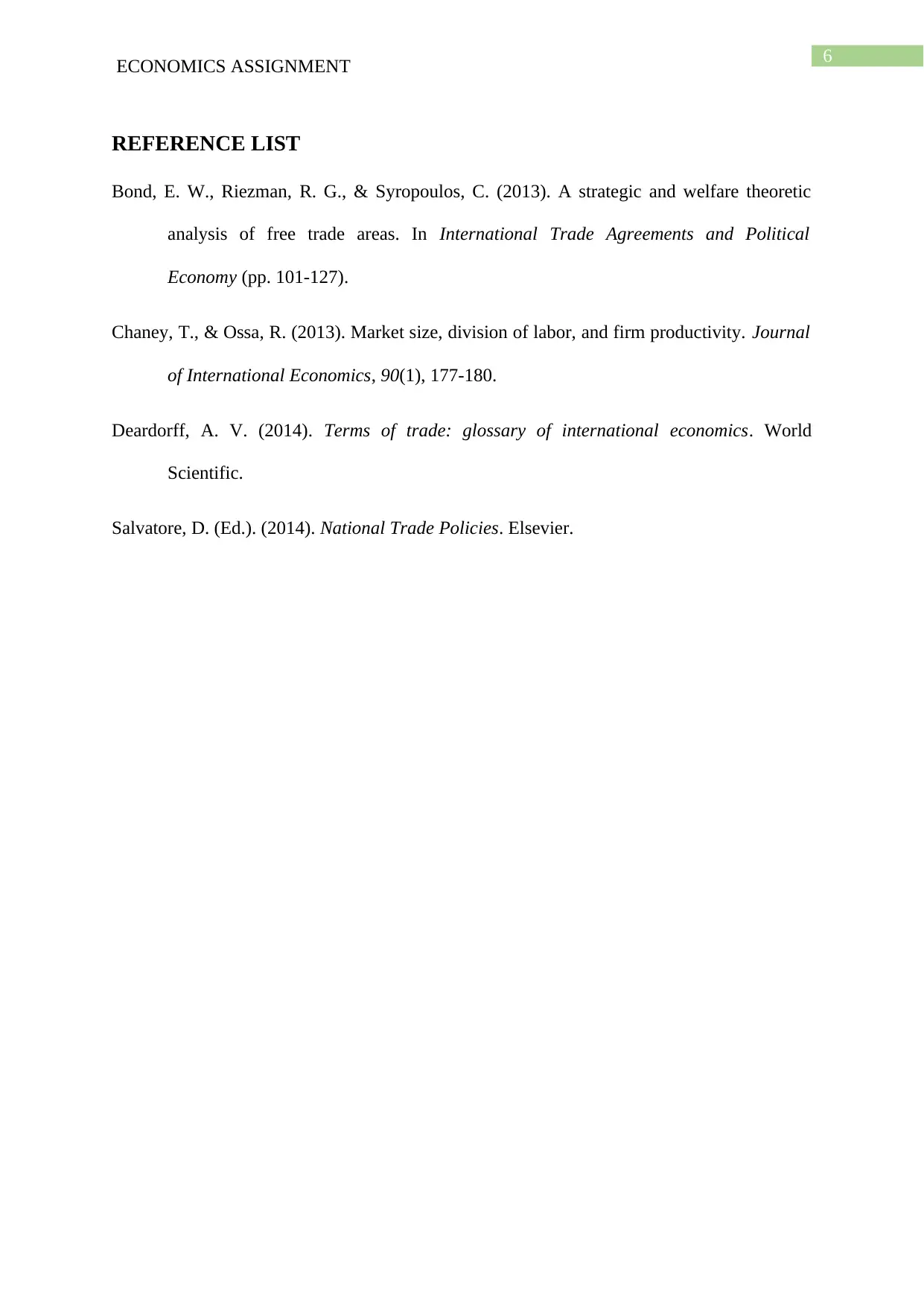
6
ECONOMICS ASSIGNMENT
REFERENCE LIST
Bond, E. W., Riezman, R. G., & Syropoulos, C. (2013). A strategic and welfare theoretic
analysis of free trade areas. In International Trade Agreements and Political
Economy (pp. 101-127).
Chaney, T., & Ossa, R. (2013). Market size, division of labor, and firm productivity. Journal
of International Economics, 90(1), 177-180.
Deardorff, A. V. (2014). Terms of trade: glossary of international economics. World
Scientific.
Salvatore, D. (Ed.). (2014). National Trade Policies. Elsevier.
ECONOMICS ASSIGNMENT
REFERENCE LIST
Bond, E. W., Riezman, R. G., & Syropoulos, C. (2013). A strategic and welfare theoretic
analysis of free trade areas. In International Trade Agreements and Political
Economy (pp. 101-127).
Chaney, T., & Ossa, R. (2013). Market size, division of labor, and firm productivity. Journal
of International Economics, 90(1), 177-180.
Deardorff, A. V. (2014). Terms of trade: glossary of international economics. World
Scientific.
Salvatore, D. (Ed.). (2014). National Trade Policies. Elsevier.
1 out of 7
Related Documents
Your All-in-One AI-Powered Toolkit for Academic Success.
+13062052269
info@desklib.com
Available 24*7 on WhatsApp / Email
![[object Object]](/_next/static/media/star-bottom.7253800d.svg)
Unlock your academic potential
Copyright © 2020–2025 A2Z Services. All Rights Reserved. Developed and managed by ZUCOL.




